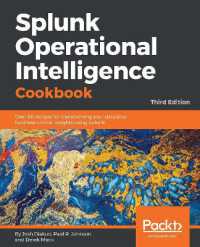- ホーム
- > 洋書
- > 英文書
- > Internet / Web Programming
Full Description
Intelligently connect data points and gain a deeper understanding of environmental problems through hands-on Geospatial Data Science case studies written in Python
The book includes colored images of important concepts
Key Features
Learn how to integrate spatial data and spatial thinking into traditional data science workflows
Develop a spatial perspective and learn to avoid common pitfalls along the way
Gain expertise through practical case studies applicable in a variety of industries with code samples that can be reproduced and expanded
Book DescriptionData scientists, when presented with a myriad of data, can often lose sight of how to present geospatial analyses in a meaningful way so that it makes sense to everyone. Using Python to visualize data helps stakeholders in less technical roles to understand the problem and seek solutions. The goal of this book is to help data scientists and GIS professionals learn and implement geospatial data science workflows using Python.
Throughout this book, you'll uncover numerous geospatial Python libraries with which you can develop end-to-end spatial data science workflows. You'll learn how to read, process, and manipulate spatial data effectively. With data in hand, you'll move on to crafting spatial data visualizations to better understand and tell the story of your data through static and dynamic mapping applications. As you progress through the book, you'll find yourself developing geospatial AI and ML models focused on clustering, regression, and optimization. The use cases can be leveraged as building blocks for more advanced work in a variety of industries.
By the end of the book, you'll be able to tackle random data, find meaningful correlations, and make geospatial data models.What you will learn
Understand the fundamentals needed to work with geospatial data
Transition from tabular to geo-enabled data in your workflows
Develop an introductory portfolio of spatial data science work using Python
Gain hands-on skills with case studies relevant to different industries
Discover best practices focusing on geospatial data to bring a positive change in your environment
Explore solving use cases, such as traveling salesperson and vehicle routing problems
Who this book is forThis book is for you if you are a data scientist seeking to incorporate geospatial thinking into your workflows or a GIS professional seeking to incorporate data science methods into yours. You'll need to have a foundational knowledge of Python for data analysis and/or data science.
Contents
Table of Contents
Introducing Geographic Information Systems and Geospatial Data Science
What Is Geospatial Data and Where Can I Find It?
Working with Geographic and Projected Coordinate Systems
Exploring Geospatial Data Science Packages
Exploratory Data Visualization
Hypothesis Testing and Spatial Randomness
Spatial Feature Engineering
Spatial Clustering and Regionalization
Developing Spatial Regression Models
Developing Solutions for Spatial Optimization Problems
Advanced Topics in Spatial Data Science







